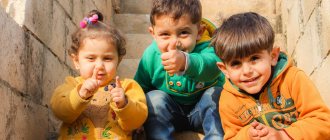A child “punishes” himself without waiting for his parents to punish him—sound familiar? He hurts himself, hits his head - where does this behavior come from and what can it turn into when he becomes an adult?
Petya is 2 years old, he is a vulnerable and slightly shy child. For the last month he has been forced to live with his grandmother, because her parents are going through a very difficult period - divorce proceedings. The once happy family began to collapse literally before our eyes after dad was fired from work. The child increasingly witnessed quarrels and fights between parents. After another conflict, my mother’s patience came to an end, and she took Petya to the village to see her grandmother.
Every time after his mother left, the boy would cry for a long time and forcefully pinch himself on the skin around his wrist. Even my favorite toys and delicious treats, carefully prepared by my grandmother, did not help. And also, when something didn’t work out for him during games, he banged his head against the wall. This behavior began to frighten my grandmother. Why does an affectionate, vulnerable boy, no different from his peers, have so much aggression towards himself?
What are children's whims and what is their nature?
This is a question for which there is no encyclopedic answer. All adults put different meanings into this word. In fact, parents are more often faced with a child’s violent emotional reaction to some undesirable events for him, calling it whining, hysterics, whims, which in fact it is not. The baby does not yet know how to express his desires and feelings in other ways. Much also depends on the child’s temperament: if he is easily excited, it is difficult for him to stop, then he will scream, fight, cry and stomp his feet more often than his peers. And this does not mean at all that the child is poorly brought up - it’s just that the processes of self-regulation in him have not yet matured. And this, of course, requires a lot of patience from parents.
Auto-aggression in adults
Adults who were constantly told in childhood that being angry is bad, that good boys and girls do not behave this way, as they age experience problems with violating their own boundaries, they may have anxiety and depressive disorders, and a tendency toward suicidal behavior. By suppressing emotions at the level of internal sensations, a person becomes defenseless in relation to stress, thereby injuring himself.
Maxim is 27 years old, and only a few months ago, on the advice of his wife, he turned to a psychotherapist for help. The wife began to be afraid of the consequences of their quarrels. After the conflict gained momentum, Maxim went into the storage room and hit the wall with all his fists. He could not explain the behavior, and for a long time he had become accustomed to coping with stress through physical pain.
The guy did not consider his behavior unusual. After all, since childhood, he was accustomed to expressing negative emotions in this way. One day, at the age of 16, after a scandal with my stepfather, the knife itself ended up in my hands. Within a minute, shallow cuts scattered across his left arm like a bunch of grapes. It became easier, but due to his family’s threats of forced treatment in a psychiatric hospital, he no longer resorted to this method. Fighting with a wall was much more common.
There was also a period of alcohol addiction in his life, which ended happily after meeting his future wife. After two months of close work with a psychotherapist, the first successes appeared. Maxim’s hands have finally healed, and the number of quarrels has sharply decreased.
Is it important to correct auto-aggression in childhood? Without a doubt. By turning a blind eye to a child’s behavior, we ourselves create the preconditions for many problems in future adult life. In order for a child to grow up with an internal sense of strength and not expose himself to deviant behavior, we must make every effort to correct it, and not be inactive.
Signs
Each hysterical child behaves differently during an attack. Someone might just stomp their feet and yell loudly. Others start rolling on the floor. But the most dangerous are those who, by splashing out negativity and aggression, cause damage to themselves and others. Parents need to know how this happens to their baby. This will allow you to take the necessary security measures in a timely manner.
Before hysterics, many seem to “prepare” for the upcoming performance. If you manage to catch this moment, you can prevent an attack. This is signaled by special harbingers:
- slight whimpering;
- snuffling, puffing, grumbling;
- pursed or trembling lips (someone sticks out their lower lip offended);
- a frowning glance from under his brows at the one on whom the satisfaction of desire depends;
- eyes full of tears;
- closed pose (arms clasped in front of you);
- methodically rocking the body (sitting on a chair or just standing);
- nervous, sudden movements;
- red face.
Precursors are not always demonstrated - attacks often begin unexpectedly and abruptly. What does a child usually do when hysterical?
Key symptoms of the crisis: 7 major changes
To one degree or another, the manifestations have similar features in all children; only the severity of the key characteristics of the 3-year-old crisis differs. Parents describe common manifestations as changes in behavior and disobedience, scandals and hysterics, tears literally over every little thing. Psychologists identify 7 main symptoms of crisis behavior:
- Negativism . The child flatly refuses to follow the instructions of adults, even if this request is beneficial to the child himself. To any requests - a clear “no”.
- Obstinacy . The baby suddenly changes his habits and does not want to adhere to the regime. Through scandals and hysterics, he tries to win the right to do as he wants.
- Stubbornness . The child makes a decision and strictly adheres to this line. It is impossible to force, persuade or motivate him to do certain habitual actions. He will cry, but clearly stand his ground.
- Self-will . The baby wants to do things on his own, ignoring the parents' prompts or words.
- Protest . The peculiarities of this characteristic are a storm of emotions in relation to his parents’ instructions about what he should do. If parents have chosen or decided something for him, the child refuses these things or actions.
- Depreciation . The baby stops appreciating those things or actions that were previously important, loved or dear to him. He may throw and break his favorite toys, call his parents names, fight with his brothers and sisters, and refuse his favorite treats.
- Despotism . The child tries to command family members, demands submission and unquestioning obedience. If his whims are not fulfilled, hysterics and screams follow, stamping his feet and raising his voice. Source: D.M. Shakirova, A.F. Gilmanova. Age crises in children of preschool and school age // Skif. Student Science Questions, 2021.
Not all of these signs may manifest themselves equally clearly; sometimes certain symptoms predominate, which are triggered most often and which the child uses as an instrument of influence.
Child's night tantrums
It happens that a child wakes up at night with hysterics, but does not know what he wants, and it is very difficult to calm him down.
As a rule, a child's night hysteria begins no earlier than an hour after falling asleep, and is the result of a nightmare that can return several times during the night.
The child wakes up hysterical, with eyes wide open in fear, breathing heavily, covered in sweat. With night fear syndrome, a child wakes up at night in hysterics, does not recognize his parents, pushes them away, moves randomly, hits others and himself, without realizing it. During this period, there is no way to distract or calm the child; you just have to make sure that he does not cause any harm to himself during the attack.
This condition is not considered pathological and does not in itself indicate neurological or mental disorders. As a rule, children simply “outgrow” it.
Usually the next morning the baby no longer remembers how he behaved at night, so if the child has a hysteria before bed, then it is definitely not associated with the fear of nightmares.
Methods for correcting auto-aggression
One of the effective methods is daily work on the development of the child’s emotional intelligence and familiarization with basic emotions. Parents must understand that emotions cannot be “bad” or “good.” The final result is not to ban or avoid negative feelings, but to learn how to express them correctly.
Here is a short algorithm for the behavior of a parent faced with child auto-aggression.
1. Position yourself at the child’s eye level, indicate its condition and cause. Calmly, without intonation, say everything that the child feels at the moment: “You are angry because I didn’t allow you to go for a long walk.”
This way you allow your baby to get acquainted with his emotions, because he is at an age when he does not yet distinguish the whole gamut of feelings that he experiences. The parent in this situation takes on the role of a mirror, verbally reflecting the action.
One of the key points is your attitude towards the child. If the mother says this from her height or even turning away, the method will be ineffective.
2. It is important to support the child and accept his feelings: “Yes, I understand how upset you are now and you want to go for a walk.”
This way of supporting and accepting feelings makes the child understand that his parents “hear” him and are on the wrong side of the barricades. Many adults think that it is pointless to do this, that such phrases are very unnatural. In principle, it is difficult for some to adapt to a new style of communication.
It may come as a surprise to you, but talking through and accepting your child’s feelings is mutually beneficial for a harmonious parent-child relationship. Parents, working through the child’s feelings every day, begin to better understand the baby and move away from ineffective parenting models: screaming, aggression, physical punishment. In the end, a compromise is found.
3. The parent offers an alternative to expressing these feelings: “If you're angry, stomp your foot; crumple the paper, etc.”
Experiencing feelings is one of the effective ways to develop emotional intelligence. It is best for young children to experience negative emotions through actions: tearing something, crushing it, stomping on it, throwing something.
After the action is completed, the parent should calmly comment on it. The child must realize that emotions such as anger, anger, rage are normal. With age, when the central nervous system matures, it will be enough for him to express himself not in a physical way, but in a verbal way, for example: “I’m outraged,” “I’m furious,” “I feel bad,” “I don’t like this.”
4. Next, the parent proposes a specific action to resolve the current situation: “We will definitely go out for a walk after lunch and take a scooter with us.”
This explanation helps prevent the child from feeling hopeless in a situation of refusal and makes it easier to find a compromise.
At first, the baby may resist the parent’s unusual tactics. The new rules initially cause protest behavior in many people, but over time the habit forms and self-aggression goes away.
Also, fairytale therapy can be used in correction - a very effective and efficient tool for working through a traumatic episode through the plot of a favorite fairy tale.
First of all, you need to clearly identify the problem. In this case, it is aggression directed at oneself. Next, you need to choose a suitable fairy tale; you can come up with a plot yourself. In such stories, the main character is important, who faces the same problem as the child. Children are more enthusiastic about stories where there are characters with the same problems as them.
The context of the story may be completely different from real life, since miracles and extraordinary events are appropriate in a fairy tale. The most important thing is that at the end of the story the main character overcomes all obstacles and conquers fears.
Working methods for correcting auto-aggression can additionally include psychotherapeutic activities, including play, sand and art therapy, and relaxation games.
Help for autism at EMC
If the diagnosis is established, it is necessary to immediately begin working with the child, and this work must be comprehensive:
- The psychiatrist selects drug therapy (if abnormalities are detected before the age of 1 year, you can often do without medications).
- A psychologist, neuropsychologist and defectologist draw up an autism correction program and regularly work with the child, conducting various classes, testing, and games.
To achieve the best result, complex work of specialists is important, and not just one psychiatrist. It is important not to waste time, but to correct autism at an early age.
Content
- Essence and features
- Causes
- Symptoms of crisis in a 7 year old child
- Duration
- How to cope: advice to parents from psychologists
- Consequences
Each leap in physical and psychological growth in children is accompanied by a special transition period - a crisis.
At seven years old, the child reaches the next stage of development. A preschooler becomes a schoolchild, and his social status changes. New responsibilities appear, adults begin to make other demands, and the daily routine becomes different. The psyche experiences a shock, which is accompanied by worries, a change in habitual behavior, and difficulties with communication. Therefore, in developmental psychology, children have a crisis of 7 years. When games change to active learning, the social circle changes and a different social role is formed, the child becomes disobedient, stubborn, and irritable. Signs of a mental crisis can appear between the ages of five and eight years. To help correctly overcome this difficult stage and take a new social position, parents must recognize the crisis in time and respond to it correctly.
Prevention
Fall prevention is the best way to keep your child from getting a head injury. However, accidents do happen. After a fall, it is important to reevaluate the safety and security of children at home.
Never leave a child unattended on an adult bed, even if the pillows are in place, to prevent them from getting close to the edge. In addition to falls, adult beds pose a risk for other types of accidents, including entrapment and suffocation.
Also, do not place a car seat or booster seat on top of a raised surface, even after you have secured your child.
Always put your baby in a crib when leaving him alone in the room. There should be no soft bedding in the crib that could crush or suffocate the baby.











